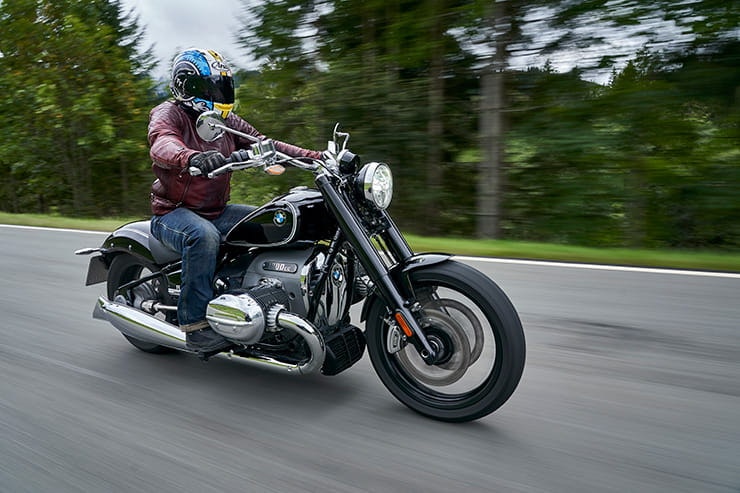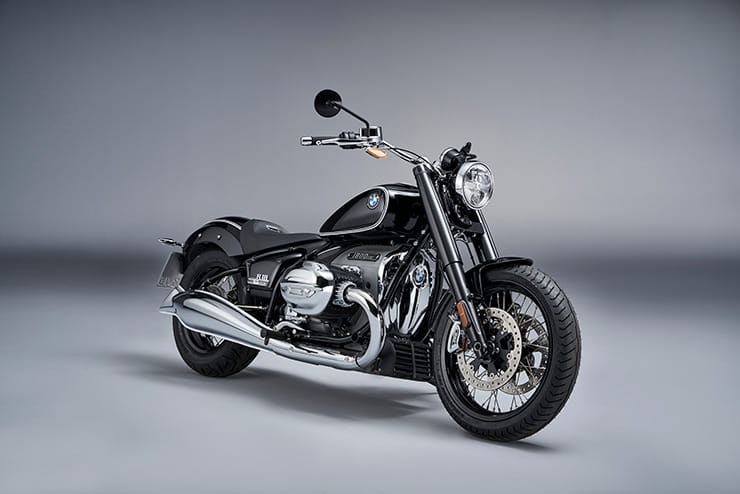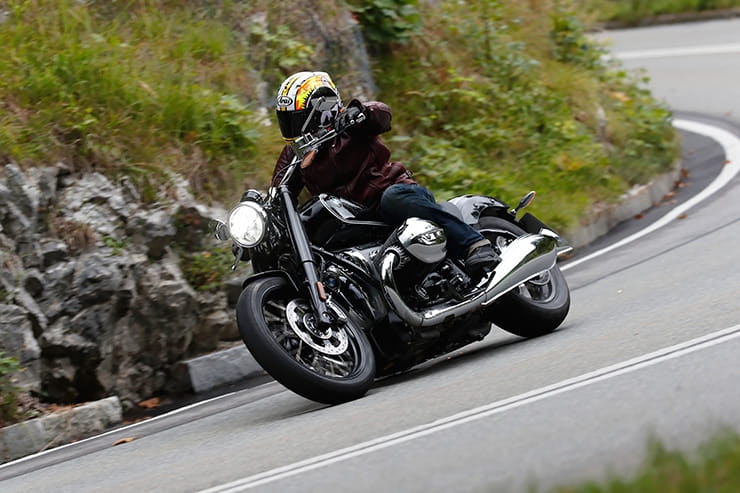BMW R 18 (2020) - Review
BikeSocial Road Tester
12.10.2020
When was the last time a cruiser had such global appeal? Even dedicated sports bike fanatics can’t help but appreciate the design, looks and elegance of BMW’s R 18. It’s a stunning bike in the flesh, a work of art, and is clearly inspired by BMW’s early boxer machines from the 1920s and ’30s like the R 32 and R 5. Elements are almost art deco, like the R7 prototype from 1934. It doesn’t scream at you like a carbon winged BMW M1000RR, and it’s not covered in lavish in chrome like a Harley – it’s unique and clearly a BMW.
The frame blends into the swing-arm to give the impression it’s a traditional hardtail. The fishtail exhausts mirror the R 5 from 1936, the exposed nickel-plated shaft drive is lovely, even the little manual chrome lever which activates a reverse gear is neatly tucked away (optional extra). The centrally mounted clocks have ‘Berlin Built’ inscribed on the dials, the double pinstriping appears hand-painted. In fact, the R looks like a one-off special, not a mass-produced bike which has just been wheeled off the production line. It’s classical yet has up-to-date clocks, LED lights, modern suspension, and rider aids. I really like it, and obviously, that huge air-cooled 1800cc boxer is the king-pin which holds the design together and gives the R 18 such a distinctive image. It’s all about the engine.
For a standard production bike, it’s stunning, like it’s just rolled out of a museum, but it still has to work and handle. So, is 345kg simply too much bulk? Have BMW managed to make 1802cc rideable? We head to Germany for a 180-mile ride to find out.
Looks, elegant style
Engine character and torque
Handling for this type of bike
Dash has limited data
No cruise control standard
Rider aids are not lean sensitive
BMW R 18 ridden
Guest road tester, Adam Child, becomes the König der Straße as he rolls around Germany on BMW’s new, big, air-cooled, boxer twin cruiser.
2020 BMW R18 Price
£18,995 (test bike £20,670 with optional heated gips, hill start, reverse gear, headlight pro fitted)
There are two trains of thought here. One is that close to £19,000 is a lot of money for a single-seat cruiser which doesn’t even have cruise control (and given the accessories list is so appetising, few models will leave a BMW showroom in standard trim). The other is that the price is justified in the quality, appeal and desirability of the new R 18. Not only are you buying into the high-end BMW brand, but this is a completely new model for 2020, unique and huge – a lot of bike for your buck.
Compared to the competition it’s somewhere in the middle ground. Harley-Davidson has the Softail and Deluxe, which you could argue are the closest competition to the BMW, and both are considerably cheaper than the Beemer. Then at the other end of the scale is the Indian Vintage Dark Horse, £21,399, and Triumph’s Rocket 3 at £19,500.
I think it’s priced competitively for today’s market. It’s a hard one to call as you could argue the R 18 doesn’t have any direct competition, but when sports bikes are pushing £20,000 and BMW’s own K 1600B is over £19,000 I think the price is in the ballpark.
Power and torque
There is no hiding the fact that this is a huge boxer engine. Each cylinder has a 107.1mm bore size, the pistons are as large as my hand. The engine, including the gearbox and intake system, weighs 110.8kg. As you’d expect from a 1802cc air-cooled engine, peak power and torque are way down in the rev range. Peak power is 91hp at just 4750rpm and the huge 116.5ftlb of torque is at 3000rpm, barely ticking over. This is the most torquey boxer engine ever used in a motorcycle, even between 2000-3000rpm there is over 110ftlb of torque.
The on-paper figures are there to back up the visually impressive motor. I can’t remember the last time an engine sat so centre stage on a motorcycle. But as impressive as they are, torque and power are slightly down compared to its American V-twin competitors.
Engine gearbox and exhaust
When you throw a leg over the relatively low seat you’re immediately drawn to the engine, like a seagull to spilled chips. Each protruding cylinder head is almost overpowering, it feels very alien to see so much engine whilst still seated on the bike. The right cylinder is set closer to the rider, as it sits further back on the crank which runs the centre line of the bike. There’s an additional third bearing on the crank which moves the pistons further apart, which exaggerates the appearance of the opposed cylinders. When your feet are on the mid-way pegs, your shins are close to the huge cylinders, you can feel the heat in traffic, which on test proved beneficial, drying out my wet boots and jeans after a downpour. It will be interesting to see how much heat is generated in the middle of summer in a warmer climate. Your right foot, covering the back brake, is almost directly underneath the cylinder. It’s not annoying, just quirky, which adds to the appeal of the R 18.
The engine starts with a charismatic rock, and If you have never ridden an opposed twin before, it may take you by surprise. Each blip of the throttle pushes the bike to the left. Again, I applaud this quirkiness. At tick-over, around 900rpm, displayed on a digital clock, the bar ends dance around while the instruments vibrate slightly, adding to the appeal. It has character all right, something I was afraid BMW would dilute.
It’s a shame the fish-tail twin exhausts don’t sound as good as they look. There is a little bark when you start up the big motor, but after that it’s a little tame. I know BMW must conform to Euro-5, and on large throttle openings there is a rumble, but from such a large, charismatic engine I was hoping for a little more. I don’t want it to be annoying, not an American V-twin with straight pipes, which scares dogs and pensioners, but just something would be nice, the odd pop on the overrun. It’s like waking a rottweiler, which barks like a Jack Russell.
The power is smooth, the fuelling is excellent, and you can really feel the difference in the power modes, Rain, Roll and Rock – no, I’m not joking. As you’d expect all the work is low down in the rev range; just tickle the throttle for progressive acceleration, you don’t really need to pass 3000rpm. Peak power is at 4750rpm but after that it tails off to eventually find a soft rev limiter just after 5500rpm. It does get a little vibey in the last quarter of the rev range, noticeably above 4000rpm, but if you’re revving it that hard, then you’re not really riding the big boxer how it was designed.
Instead, simply short shift and enjoy the torque. The gearbox is smooth, but for me it feels like it need a heel and toe gearshift and footboards (optional) rather than standard pegs and gear lever. The revs noticeably drop when you change from fifth to sixth gear. It will happily pull from just over 1200rpm in top but usually, at town speed, I was back to fifth. Sixth gear is noticeably tall, which is perfect for cruising.
On the motorway at 60mph the big girl is plodding along at 2200rpm. At 75mph, revs increase a little to 2500rpm, effortless and smooth. Once you push on a little to 85mph and above, it’s closer to 3000rpm with the vibrations noticeable. And it’s a shame the cruiser doesn’t have cruise control as standard, which is what I’d expect from this type of bike priced at £19,000.
2020 BMW R18 Economy
Before riding the R 18 I did wonder about the fuel economy and range from the 16-litre fuel tank. Each cylinder is huge, it has the aerodynamic drag of a London bus, and let's not forget about the weight, so it should be horrendous. But as it revs so slowly, like a canal boat, it’s actually not that bad with BMW claiming just over 50mpg. On our 180-mile ride, a mixture of motorway and mountain passes south of Munich towards Austria, I managed 54mpg. In theory, you can expect over 200 miles before needing to fill up, though in fact it’s closer to 130-140miles before the fuel light illuminates.
Personally, especially on this type of bike, I prefer a fuel gauge or range indicator, so I know how much fuel is remaining before each journey. I much prefer to start planning for a re-fuel, rather than panicking when the light comes on. Plus, I hate getting fully kitted up and ready, start the ride, only to then see the fuel light illuminate after 10 miles. And while I’m having a gripe, the ignition is keyless, but the fuel cap and steering lock are not, so you still have to carry and deploy key, which defeats the object of having a keyless ignition.
Handling, suspension chassis and weight
I would have loved to have been in the original design meeting with the chassis development team… ‘So we are going to have an 1802cc boxer engine weighing 110kg in a cruiser chassis. And you want me to hide the rear shock and run a 19-inch front wheel and 16-inch rear. Oh, you also want have a massively long wheelbase but still want it to handle…’ It’s an impressive job for BMW to make the chassis work, and it does.
There is no getting away from the fact this a 345kg bike; add the rider and we’re easily over 400kg, getting close to the weight of a decent international rugby front row. Some bikes hide their weight once moving, and the BMW does this, feeling far lighter than it is, but those huge protruding cylinders and the rock between gear changes are a constant reminder of the bike’s girth. You’re always aware you’re on a big bike, weight is low down, but unlike an American V-twin, you can actually see the engine and think about that weight before attempting a series of bends at speed.
The relatively basic set up is impressive. The forks don’t dive or buckle, the shock and ride are impressive, it feels like the font is communicating with the rear and vice-versa. Some big cruisers feel like the front was designed by one team and the rear by another, or they thought about the looks but left the handling for Friday afternoon. The BMW breaks that rule, this is a bike that has clearly been designed from the ground up.
Rather than steer into corners, it rolls in like a hippo in a mud-bath. You roll the bike over its large front wheel and onto its side. It’s relatively easy to deck the pegs, which thankfully are hinged and not fixed. But even when the pegs cause a rooster of sparks it doesn’t feel like the BMW is on the limit and about to head into the nearest hedge or take down a small house.
Over longer periods the set-up did feel on the firm side, which I guess is the pay-off for having suspension that doesn’t wallow and force the bike wide when ridden with the faintest bit of aggression. The riding position is comfortable, the bars not too wide, and the vibrations are apparent but not annoying in any way, though I did have numb-bum after a full day in the saddle. Again, I might be reaching for a plusher aftermarket seat in the accessories catalogue before embarking on any serious long-distance touring.
Brakes
Like the chassis, BMW is asking a lot of the twin 300mm discs and four-piston calipers because trying to stop 345kg is no easy task – like stopping a S1000RR with three riders. The front brake lever in fact activates the front brake only, but the rear is linked to the front, which gives the sensation of a strong rear brake.
The BMW stoppers are strong, and even under heavy use didn’t show any sign of fade. The lever is adjustable and there’s a nice feel. ABS comes as standard, isn’t too intrusive on the front, but it’s relatively easy to get the rear ABS activating, especially in the wet. Unusually for BMW, the ABS is not lean sensitive, and while you could argue cornering ABS isn’t required on a low revving cruiser, on such a large heavy bike, it would certainly be welcome.
Because there is so much compression from the huge engine, BMW has fitted an engine braking management system, which prevents the rear from locking up during fast down changes. At times you can feel this working, reducing the engine braking, giving a two-stroke feeling as the bike carries speed into corners. Once or twice this caught me out slightly, as the bike rolled into a turn a little quicker than expected without the engine braking I anticipated.
2020 BMW R18 Rider aids and extra equipment/accessories
Clearly the marketing team named the rider modes, Rain, Rock and Roll, which translate to rain, road and sporty. The rider aids only change the engine performance and character, and do not alter the standard traction control or ABS. There is a noticeable step in the throttle response and power between the mode: Rain is very soft and lethargic whereas the Rock mode is responsive and direct but not too sharp, a mistake some manufacturers make. In the wet or when grip is reduced, the Rain mode is beneficial and isn’t just a gimmick, as with so much power and torque it’s easy to lose traction.
The standard traction control, which can be deactivated or reinstalled on the move, will obviously prevent any major slides or wheelspin, but again, like the braking, isn’t lean-sensitive and is relatively basic. Yes, it works, and the reintroduction of the power is soft, which means that once the rear starts to spin it shouldn’t spin again when the power comes back on line. However, shouldn’t we expect lean-sensitive traction control from a premium BMW?
As you’d expect the list of accessories is huge and designed and built in partnership with legendary bike designers like Roland Sands, and Vance & Hines. The R 18 is really a blank canvas for your imagination to run wild. I left my trip to Germany thinking: heal and toe lever and foot boards, V&H pipework, relaxed bars, and a pillion seat. The ‘hipster’ clothing matches the high-end finish to the accessories. Some may sneer at the marketing and image, but cleverly BMW have created a stunning bike, which can easily be modified and personalised. I doubt very few models will leave showrooms standard.
Rivals
2020 BMW R 18 Verdict
I can’t applaud BMW enough for producing such a dramatic cruiser, so different from anything else on the market. The cruiser market has been ticking over for decades with similar V-twin models, but now BMW has entered with a huge boxer statement, on looks alone I love it. It’s a 2020 model dressed for the 1920s and 1930s. The dramatic Boxer engine holds the design together whilst delivering some ‘real-world’ performance and, for a big bike, it will go around corners scraping its pegs all day long. Yes, it’s heavy, yes it rocks from side to side and vibrates at high revs, but that is what I wanted… some soul.
The finishing touches like the exposed shaft drive are lovely, which means I can forgive its niggles like the lack of a fuel range/gauge, no keyless fuel cap, and no cruise control as standard. This is BMW’s first venture into the cruiser market for some time and they’ve done a remarkable job. In the way BMW jumped into the sports bike market in 2008 with the S1000RR and took over, the R 18 has the potential to repeat the story. The traditional cruiser competition should be worried.
2020 BMW R 18 Technical Specification
Looking for bike insurance? Get a quote for this motorcycle with Bennetts motorbike insurance
What is MCIA Secured?
MCIA Secured gives bike buyers the chance to see just how much work a manufacturer has put into making their new investment as resistant to theft as possible.
As we all know, the more security you use, the less chance there is of your bike being stolen. In fact, based on research by Bennetts, using a disc lock makes your machine three times less likely to be stolen, while heavy duty kit can make it less likely to be stolen than a car. For reviews of the best security products, click here.
MCIA Secured gives motorcycles a rating out of five stars, based on the following being fitted to a new bike as standard:
A steering lock that meets the UNECE 62 standard
An ignition immobiliser system
A vehicle marking system
An alarm system
A vehicle tracking system with subscription
The higher the star rating, the better the security, so always ask your dealer what rating your bike has, and compare it to other machines on your shortlist.


